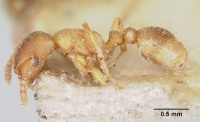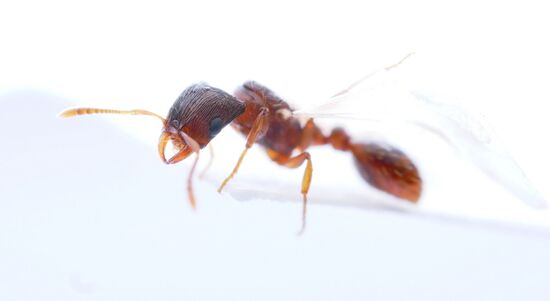Strongylognathus testaceus
| Strongylognathus testaceus | |
|---|---|

| |
| Scientific classification | |
| Kingdom: | Animalia |
| Phylum: | Arthropoda |
| Class: | Insecta |
| Order: | Hymenoptera |
| Family: | Formicidae |
| Subfamily: | Myrmicinae |
| Tribe: | Crematogastrini |
| Genus: | Strongylognathus |
| Species: | S. testaceus |
| Binomial name | |
| Strongylognathus testaceus (Schenck, 1852) | |
| Synonyms | |
| |
This species is a queen-tolerant inquiline and is only found in nests with its hosts Tetramorium alpestre, Tetramorium brevicorne, Tetramorium caespitum, Tetramorium ferox, Tetramorium impurum and Tetramorium moravicum (de la Mora et al., 2021; Sanetra & Buschinger, 2000; Seifert, 2018). It occurs in a range of habitats including steppe habitats and pine forests in Russia (Zryanin & Zryanina, 2007).
| At a Glance | • Inquiline |
Photo Gallery
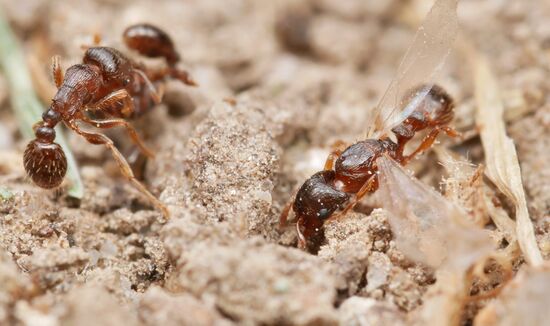 Strongylognathus testaceus queen near a nest of its host, Tetramorium caespitum (workers to the left). When the workers noticed her she was attacked. Darmstadt, Germany. Photo by Philipp Hönle.
Strongylognathus testaceus queen near a nest of its host, Tetramorium caespitum (workers to the left). When the workers noticed her she was attacked. Darmstadt, Germany. Photo by Philipp Hönle. Tetramorium atratulum dealate gyne moving freely in Tetramorium caespitum nest associated with the social parasite Strongylognathus testaceus (photo: A. Purkart, from Purkart et al., 2021, Fig. 8).
Tetramorium atratulum dealate gyne moving freely in Tetramorium caespitum nest associated with the social parasite Strongylognathus testaceus (photo: A. Purkart, from Purkart et al., 2021, Fig. 8).
Identification
Yellowish brown. Head rectangular with pronounced occipital emargination and postero-lateral angles. Body shining with long fine pale hairs present also on appendages. Sculpture variable, with longitudinal striae present or more or less effaced on head and mesosoma. Length: 2.0-3.6 mm (Collingwood 1979).
Distribution
Pyrenees to Ukraine, North Italy to Sweden (Collingwood 1979).
Latitudinal Distribution Pattern
Latitudinal Range: 57.415378° to 36.833333°.
| North Temperate |
North Subtropical |
Tropical | South Subtropical |
South Temperate |
- Source: AntMaps
Distribution based on Regional Taxon Lists
Palaearctic Region: Andorra, Austria, Azerbaijan, Belarus, Belgium, Bulgaria, Croatia, Czechia, Georgia, Germany (type locality), Greece, Hungary, Iberian Peninsula, Lithuania, Netherlands, Poland, Republic of Moldova, Romania, Russian Federation, Slovakia, Slovenia, Spain, Sweden, Switzerland, Türkiye, Turkmenistan, Ukraine, United Kingdom of Great Britain and Northern Ireland.
Distribution based on AntMaps
Distribution based on AntWeb specimens
Check data from AntWeb
Countries Occupied
| Number of countries occupied by this species based on AntWiki Regional Taxon Lists. In general, fewer countries occupied indicates a narrower range, while more countries indicates a more widespread species. |
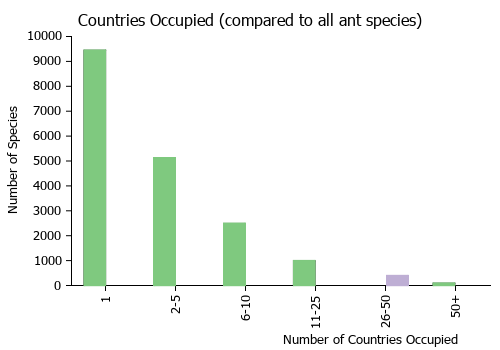
|
Estimated Abundance
| Relative abundance based on number of AntMaps records per species (this species within the purple bar). Fewer records (to the left) indicates a less abundant/encountered species while more records (to the right) indicates more abundant/encountered species. |

|
Biology
Collingwood (1979) - This species occurs only in the nests of its host Tetramorium caespitum. Workers and brood of both host and parasite are present but only the sexuals of Strongylognathus are developed, the original Tetramorium queen as well as the adoptive Strongylognathus queen usually being found present together.
S. testaceus workers are normally greatly outnumbered by Tetramorium workers. Observations on this and related species suggest that neighbouring nests of the host species are raided to recruit more Tetramorium pupae to the colony which is often very populous with up to 20,000 individuals. Alatae are present in July and August.
Guillem et al., 2014 - S. testaceus is a degenerate slave-maker of Tetramorium caespitum and T. impurum. The Strongylognathus queen does not kill the host queen, but instead pheromonally inhibits production of the host sexual brood. As the number of parasite workers rarely exceeds 1%, they rarely (or perhaps never) raid additional colonies for extra slaves (Sanetra and Gusten, 2001; Czechowski et al., 2002; Tinaut et al., 2005). Thus, this species may be considered an intermediate stage between slave-makers and inquilines.
Strongylognathus testaceus were collected from two colonies of Tetramorium c.f. impurum and a single colony of T. semilaeve in the Catalan Pyrenees, Spain during June 2011. Colonies were found under stones. The colony found with T. semilaeve contained S. testaceus sexuals (both males and females). Within Iberia, S. testaceus has only been recorded from T. caespitum and T. impurum (Tinaut et al., 2005), so this is also the first record of S. testaceus with T. semilaeve. Approximately one in 50 colonies of Tetramorium was parasitized.
Guillem et al. (2014) examined cuticular hydrocarbon (CHC) profiles between this parasite and its hosts. They found that the parasitic species had CHC profiles that were indistinguishable from that of their hosts, even when the parasite is using more than one host species. The level of chemical mimicry even extended to the more subtle between-colony differences in profiles. In all cases the profiles of un-parasitized colonies were similar to those that were parasitized indicating that it is the parasites that have adjusted their profile to match that of their host and not vice versa. This explains why these social parasites are fully integrated members of each colony and are treated as nest-mates.
It should be noted that in some species, for example Harpagoxenus sublaevis (Winter and Buschinger, 1986), raiding workers are frequently killed or driven off when trying to raid or invade new host colonies, since they are carrying their own host colony odour, which is likely to be different from that of the one they are raiding. This is why parasites continue to use a wide range of other chemical and morphological adaptations associated with their parasitic lifestyle. These include a thickened cuticle and production of appeasement or propaganda compounds (e.g. Allies et al., 1986; Lloyd et al., 1986; Ollett et al., 1987; D'Ettorre et al., 2000). These tactics allow the parasite time to make the necessary adjustments to its profile. Acquiring a host profile may be possible in just a few hours (R. Kather, pers. comm., cited in Guillem et al. (2014)).
Flight Period
| X | X | X | |||||||||
| Jan | Feb | Mar | Apr | May | Jun | Jul | Aug | Sep | Oct | Nov | Dec |
Source: Seifert, 2018; antkeeping.info.
- Check details at Worldwide Ant Nuptial Flights Data, AntNupTracker and AntKeeping.
 Explore: Show all Flight Month data or Search these data. See also a list of all data tables or learn how data is managed.
Explore: Show all Flight Month data or Search these data. See also a list of all data tables or learn how data is managed.
Parasitic Colony Foundation
Colony foundation behavior has not been published for any of the Strongylognathus spp. yet, but in recent years a few European hobby ant keepers have collected young queens of Strongylognathus testaceus during their mating flights. Reports are found in various ant forums:
- https://www.ameisenportal.eu/viewtopic.php?f=64&t=2404 (with pictures) in German.
- A paper in Czech language : https://ziva.avcr.cz/files/ziva/pdf/strongylognathus-testaceus-paraziticky-mravenec-se.pdf.
- A blog in Polish: http://www.myrmeblog.pl/strongylognathus-testaceus/strongylognathus-testaceus-5-2/ , showing host- and parasite queens together.
Incipient colonies with queens of both species even were sold by ant shops, eg: https://antsatan.com/product/strongylognathus-testaceus-tetramorium-caespitum/
The parasite queens were swarming simultaneously with their host species (Tetramorium cf. caespitum), or a few days later. After landing on the ground the queens of the parasite species appear to join host queens for starting claustral colony foundation together.
I myself (A. Buschinger) received three such „pairs“ from a German ant keeper. They had swarmed on 28 June 2021. In one of them about 15 Tetramorium-workers have been reared (no Strongylognathus yet) until 5 October, the two queens still cooperating. Other such founding associations of the ant keeper have produced a few Strongylognathus workers, too. These observations indicate that joined colony foundation in fact is the regular behavior of Strongylognathus testaceus!
The ant keeper produced a highly impressive video on Youtube on the behavior of a Tetramorium queen towards the small Strongylognathus queen just after the two were put together into a test tube (with water behind a stopper of cotton wool, a usual method in ant keeping): https://www.youtube.com/watch?v=YZlu8yBC2ls The Tetramorium queen is licking vigorously the Strongylognathus queen all over its body including the appendages. Probably the parasite queen has a very attractive secretion on its cuticle. The author, Eric V. Martens, has observed the mating flight of the two species on his own property, a pasture at Neetze (Germany) in the „Lüneburger Heide“ https://en.wikipedia.org/wiki/L%C3%BCneburg_Heath
These recent observations and the video might stimulate researchers to study colony foundation in the other species of Strongylognathus, most of which are considered active slavemakers.
Video of host species queen licking parasite queen
Strongylognathus testaceus and Tetramorium caespitum
Castes
Images from AntWeb
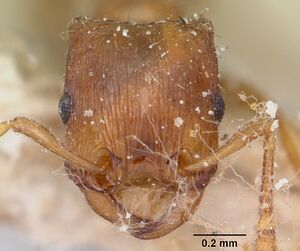   
| |
| Worker. Specimen code casent0103241. Photographer April Nobile, uploaded by California Academy of Sciences. | Owned by CAS, San Francisco, CA, USA. |
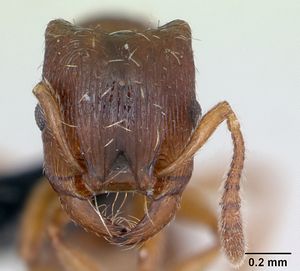   
| |
| Worker. Specimen code casent0173184. Photographer April Nobile, uploaded by California Academy of Sciences. | Owned by CAS, San Francisco, CA, USA. |
Queen
Images from AntWeb
   
| |
| Queen (alate/dealate). Specimen code casent0173185. Photographer April Nobile, uploaded by California Academy of Sciences. | Owned by CAS, San Francisco, CA, USA. |
Male
Images from AntWeb
  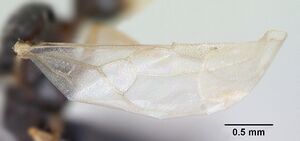   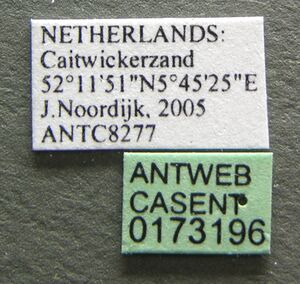
| |
| Male (alate). Specimen code casent0173196. Photographer April Nobile, uploaded by California Academy of Sciences. | Owned by CAS, San Francisco, CA, USA. |
Nomenclature
The following information is derived from Barry Bolton's Online Catalogue of the Ants of the World.
- testaceus. Eciton testaceum Schenck, 1852: 117 (w.q.m.) GERMANY.
- Type-material: syntype workers, syntype queens, syntype males (numbers not stated).
- Type-locality: Germany: Nassau (Schenck).
- Type-depository: unknown.
- [Note: according to Horn & Kahle, 1936: 242, Schenck’s Hymenoptera specimens were deposited in “Zool. Univ. Mus., Marburg”.]
- Combination in Strongylognathus: Mayr, 1853d: 390.
- Status as species: Mayr, 1853d: 390 (redescription); Mayr, 1855: 431 (footnote, redescription); Nylander, 1856b: 101; Smith, F. 1858b: 134; Mayr, 1861: 57 (in key); Roger, 1863b: 26; Mayr, 1863: 454; Dours, 1873: 169; Forel, 1874: 71 (in key); André, 1874: 188 (in key); Emery, 1878b: 52; Emery & Forel, 1879: 457; André, 1883a: 282 (in key); Lameere, 1892: 67; Dalla Torre, 1893: 130; Wasmann, 1894: 164; Forel, 1900e: 278 (in key); Wheeler, W.M. 1901c: 710; Ruzsky, 1902d: 33; Ruzsky, 1905b: 542; Viehmeyer, 1906: 67; Wasmann, 1906: 120; Forel, 1908a: 22; Emery, 1909d: 707; Wheeler, W.M. 1909g: 186; Bondroit, 1910: 499; Wasmann, 1910: 522; Karavaiev, 1912b: 585; Stitz, 1914: 76; Forel, 1915d: 15 (in key); Emery, 1916b: 198; Escherich, 1917: 324; Bondroit, 1918: 111; Soudek, 1922: 28; Kutter, 1923: 338; Emery, 1924d: 285; Vandel, 1926: 198; Betrem, 1926: 218; Stärcke, 1926: 85 (in key); Karavaiev, 1927a: 293; Karavaiev, 1927c: 271 (in key); Santschi, 1927b: 127; Lomnicki, 1928: 4; Kuznetsov-Ugamsky, 1929b: 43; Soudek, 1931: 8; Gösswald, 1932: 85; Arnol'di, 1933b: 598 (in key); Karavaiev, 1934: 160 (redescription); Grandi, 1935: 102; Donisthorpe, 1936c: 114 (in list); Finzi, 1939b: 90; Novák & Sadil, 1941: 87 (in key); van Boven, 1947: 170 (in key); Bernard, 1950a: 19; Baroni Urbani, 1962: 131; Bernard, 1967: 238 (redescription); Kutter, 1968a: 60; Kutter, 1968b: 205; Collingwood & Yarrow, 1969: 73; Baroni Urbani, 1971c: 151; Collingwood, 1971: 162; Bolton & Collingwood, 1975: 3 (in key); Pisarski, 1975: 26; Bolton, 1976: 306; van Boven, 1977: 89; Kutter, 1977c: 166; Arnol’di & Dlussky, 1978: 546 (in key); Collingwood, 1978: 86 (in key); Collingwood, 1979: 80; Agosti & Collingwood, 1987a: 57; Agosti & Collingwood, 1987b: 278 (in key); Dlussky, Soyunov & Zabelin, 1990: 210; Radchenko, 1991: 86; Atanassov & Dlussky, 1992: 156; Douwes, 1995: 91; Bolton, 1995b: 395; Poldi, et al. 1995: 6; Espadaler, 1997b: 31; Gallé, et al. 1998: 215; Sanetra, Güsten & Schulz, 1999: 343; Czechowski, et al. 2002: 70; Schulz, A. & Sanetra, 2002: 163; Tinaut, Ruano & Martinez, 2005: 468; Bračko, 2006: 140; Markó, Sipos, et al. 2006: 70; Petrov, 2006: 101 (in key); Bračko, 2007: 18; Seifert, 2007: 252; Zryanin & Zryanina, 2007: 232; Gratiashvili & Barjadze, 2008: 142; Casevitz-Weulersse & Galkowski, 2009: 493; Lapeva-Gjonova, et al. 2010: 31; Boer, 2010: 66; Csösz, et al. 2011: 57; Legakis, 2011: 20; Borowiec, L. & Salata, 2012: 537; Czechowski, et al. 2012: 187; Kiran & Karaman, 2012: 24; Borowiec, L. 2014: 165; Lebas, et al. 2016: 338; Radchenko, 2016: 258; Steiner, et al. 2017: 16; Salata & Borowiec, 2018c: 48; Seifert, 2018: 236; Werner, et al. 2018: 7.
- Senior synonym of diveri: Brown, 1955c: 113; Baroni Urbani, 1962: 131; Kutter, 1968b: 205; Collingwood, 1971: 162; Bolton, 1976: 306; van Boven, 1977: 89; Radchenko, 1991: 86; Bolton, 1995b: 395; Radchenko, 2016: 258.
- Senior synonym of emarginatus: Mayr, 1853d: 390; Mayr, 1855: 431 (footnote); Nylander, 1856b: 101; Smith, F. 1858b: 134; Roger, 1863b: 26; Dours, 1873: 169; Forel, 1874: 100 (in list); Emery & Forel, 1879: 457; Dalla Torre, 1893: 130; Ruzsky, 1905b: 542; Wheeler, W.M. 1911f: 168; Emery, 1924d: 286; Karavaiev, 1934: 160; Bolton, 1976: 306; Radchenko, 1991: 86; Bolton, 1995b: 395; Radchenko, 2016: 258.
- Distribution: Andorra, Austria, Belarus, Belgium, Britain, Bulgaria, Croatia, Czech Republic, Denmark, France (+ Corsica), Georgia, Germany, Greece, Hungary, Italy (+ Sardinia), Lithuania, Luxembourg, Moldova, Netherlands, Poland, Romania, Russia, Serbia, Slovakia, Slovenia, Spain, Sweden, Switzerland, Turkey, Ukraine.
- [Note: distribution from Borowiec, L. 2014: 165.]
- diveri. Strongylognathus diveri Donisthorpe, 1936c: 113, figs. 1, 2, 7 (w.) GREAT BRITAIN.
- Type-material: 3 syntype workers.
- Type-locality: Great Britain: England, Dorsetshire, Studland (C. Diver).
- Type-depository: BMNH.
- Junior synonym of testaceus: Brown, 1955c: 113; Baroni Urbani, 1962: 131; Kutter, 1968b: 205; Collingwood, 1971: 162; Bolton, 1976: 306; van Boven, 1977: 89; Radchenko, 1991: 86; Bolton, 1995b: 395; Radchenko, 2016: 258.
- emarginatus. Myrmus emarginatus Schenck, 1853: 188 (w.) GERMANY.
- Type-material: syntype workers (number not stated).
- Type-locality: Germany: Nassau, vii. (Schenck).
- Type-depository: unknown.
- [Note: according to Horn & Kahle, 1936: 242, Schenck’s Hymenoptera specimens were deposited in “Zool. Univ. Mus., Marburg”.]
- Junior synonym of testaceus: Mayr, 1853d: 390; Mayr, 1855: 431 (footnote); Nylander, 1856b: 101; Smith, F. 1858b: 134; Roger, 1863b: 26; Dours, 1873: 169; Forel, 1874: 100 (in list); Emery & Forel, 1879: 457; Dalla Torre, 1893: 130; Ruzsky, 1905b: 542; Wheeler, W.M. 1911f: 168; Emery, 1924d: 286; Karavaiev, 1934: 160; Bolton, 1976: 306; Radchenko, 1991: 86; Bolton, 1995b: 395; Radchenko, 2016: 258.
Description
References
- Atanassov, N.; Dlussky, G. M. 1992. Fauna of Bulgaria. Hymenoptera, Formicidae. Fauna Bûlg. 22: 1-310 (page 156, see also)
- Baroni Urbani, C. 1971c. Catalogo delle specie di Formicidae d'Italia (Studi sulla mirmecofauna d'Italia X). Memorie della Societa Entomologica Italiana 50: 5-287 (page 151, see also)
- Bernadou, A., Fourcassié, V., Espadaler, X. 2013. A preliminary checklist of the ants (Hymenoptera, Formicidae) of Andorra. ZooKeys 277, 13–23 (doi:10.3897/zookeys.277.4684).
- Blaimer, B.B., Ward, P.S., Schultz, T.R., Fisher, B.L., Brady, S.G. 2018. Paleotropical diversification dominates the evolution of the hyperdiverse ant tribe Crematogastrini (Hymenoptera: Formicidae). Insect Systematics and Diversity 2(5): 3; 1-14 (doi:10.1093/isd/ixy013).
- Borowiec, L. 2014. Catalogue of ants of Europe, the Mediterranean Basin and adjacent regions (Hymenoptera: Formicidae). Genus (Wroclaw) 25(1-2): 1-340.
- Brown, W. L., Jr. 1955c. The identity of the British Strongylognathus (Hymenoptera: Formicidae). J. Soc. Br. Entomol. 5: 113-114 (page 113, Senior synonym of diversi)
- Buschinger, A. 1987. Teleutomyrmex schneideri Kutter 1950 and other parasitic ants found in the Pyrenees (Hymenoptera, Formicidae). Spixiana 10, 81-83.
- Catarineu, C., Barberá, G.G., Reyes-López, J.L. 2018. Zoogeography of the ants (Hymenoptera: Formicidae) of southeastern Iberian Peninsula. Sociobiology 65, 383-396 (doi:10.13102/sociobiology.v65i3.2822).
- Csősz, S., Báthori, F., Gallé, L., Lőrinczi, G., Maák, I., Tartally, A., Kovács, É., Somogyi, A.Á., Markó, B. 2021. The myrmecofauna (Hymenoptera: Formicidae) of Hungary: Survey of ant species with an annotated synonymic inventory. Insects 16;12(1):78 (doi:10.3390/insects12010078).
- Csosz, S., Marko, B., Galle, L. 2011. The myrmecofauna (Hymenoptera: Formicidae) of Hungary: an updated checklist. North-Western Journal of Zoology 7: 55-62.
- Czechowski, W., Radchenko, A., Czechowska, W. 2002. The ants (Hymenoptera, Formicidae) of Poland. MIZ PAS Warsaw.
- de la Mora, A., Sankovitz, M., Purcell, J. 2020. Ants (Hymenoptera: Formicidae) as host and intruder: recent advances and future directions in the study of exploitative strategies. Myrmecological News 30: 53-71 (doi:10.25849/MYRMECOL.NEWS_030:053).
- Dekoninck, W., Ignace, D., Vankerkhoven, F., Wegnez, P. 2012. Verspreidingsatlas van de mieren van België. Bulletin de la Société royale belge d’Entomologie 148: 95-186.
- García, F., Cuesta-Segura, A.D., Espadaler, X. 2024. Myrmica babiensis sp. nov. (Hymenoptera: Formicidae), a new social parasite from the NW Iberian Peninsula. Annales Zoologici 74(1), 113-127 (doi:10.3161/00034541anz2024.74.1.006).
- Giannetti, D., Schifani, E., Castracani, C., Ghizzoni, M., Delaiti, M., Pfenner, F., Spotti, F.A., Mori, A., Ioriatti, C., Grasso, D.A. 2021. Assessing ant diversity in agroecosystems: the case of Italian vineyards of the Adige Valley. Redia 104, 97–109 (doi:10.19263/redia-104.21.11).
- Guillem, R.M., Drijfhout, F., & Martin, S.J. 2014. Chemical deception among ant social parasites. Current Zoology, 60(1), 62-75 (doi:10.1093/czoolo/60.1.62).
- Kiran, K., Karaman, C. 2020. Additions to the ant fauna of Turkey (Hymenoptera, Formicidae). Zoosystema 42(18), 285-329 (doi:10.5252/zoosystema2020v42a18).
- Kutter, H. 1977c. Hymenoptera, Formicidae. Insecta Helv. Fauna 6: 1-298 (page 166, see also)
- Lapeva-Gjonova, A., Antonova, V. 2022. An updated checklist of ants (Hymenoptera, Formicidae) of Bulgaria, after 130 years of research. Biodiversity Data Journal 10, e95599 (doi:10.3897/bdj.10.e95599).
- Lapeva-Gjonova, A., Kiran, K. 2012. Ant fauna (Hymenoptera, Formicidae) of Strandzha (Istranca) Mountain and adjacent Black Sea coast. North-Western Journal of Zoology 8(1), 72-84.
- Lapeva-Gjonova, A., Radchenko, A. 2021. Ant genus Strongylognathus (Hymenoptera, Formicidae) in Bulgaria: a preliminary review. Biodiversity Data Journal 9, e65742 (doi:10.3897/bdj.9.e65742).
- Martin, S.J., Drijfhout, F.P. 2009. A review of ant cuticular hydrocarbons Journal of Chemical Ecology 35: 1151–1161 (doi:10.1007/s10886-009-9695-4).
- Mayr, G. 1853e. Ueber die Abtheilung der Myrmiciden, und eine neue Gattung derselben. Verh. Zool.-Bot. Ver. Wien 3: 387-394 (page 390, Combination in Stronglyognathus)
- Mayr, G. 1853e. Ueber die Abtheilung der Myrmiciden, und eine neue Gattung derselben. Verh. Zool.-Bot. Ver. Wien 3: 387-394 (page 390, Senior synonym of emarginatus)
- Moss, A.D., Swallow, J.G., Greene, M.J. 2022. Always under foot: Tetramorium immigrans (Hymenoptera: Formicidae), a review. Myrmecological News 32: 75-92 (doi:10.25849/MYRMECOL.NEWS_032:075).
- Purkart, A., Wagner, H.C., Goffová, K., Selnekovič, D., Holecová, M. 2021. Laboratory observations on Anergates atratulus (Schenck, 1852): mating behaviour, incorporation into host colonies, and competition with Strongylognathus testaceus (Schenck, 1852). Biologia (doi:10.1007/s11756-021-00901-y).
- Sanetra, M., Buschinger, A. 2000. Phylogenetic relationships among social parasites and their hosts in the ant tribe Tetramoriini (Hymenoptera: Formicidae). European Journal of Entomology 97: 95-117.
- Sanetra, M., Güsten, R., Schulz, A. 1999. On the taxonomy and distribution of Italian Tetramorium species and their social parasites (Hymenoptera Formicidae). Memorie della Societa Entomologica Italiana 77: 317-357.
- Schenck, C. F. 1852. Beschreibung nassauischer Ameisenarten. Jahrb. Ver. Naturkd. Herzogthum Nassau Wiesb. 8: 1-149 (page 117, worker, queen, male described)
- Schifani, E., Csősz, S., Viviano, R., Alicata, A. 2021. Ant diversity on the largest Mediterranean islands: on the presence or absence of 28 species in Sicily (Hymenoptera, Formicidae). Natural History Sciences 8, 55–70 (doi:10.4081/nhs.2021.532).
- Schifani, E., Nalini, E., Gentile, V., Alamanni, F., Ancona, C., Caria, M., Cillo, D., Bazzato, E. 2021. Ants of Sardinia: An updated checklist based on new faunistic, morphological and biogeographical notes. Redia 104, 21–35 (doi:10.19263/redia-104.21.03).
- Seifert, B. 2018. The ants of Central and Northern Europe. lutra Verlags- und Vertiebsgesellschaft, Tauer, 408 pp.
- Snegovaya, N., Shigayev, C. 2021. A checklist of the ants (Insecta, Formicidae) of Azerbaijan Republic. Iranian Journal of Animal Biosystematics 17(2): 179-207 (doi:10.22067/ijab.2022.67343.1000).
- Wagner, H.C., Arthofer, W., Seifert, B., Muster, C., Steiner, F.M. & Schlick-Steiner, B.C. 2017. Light at the end of the tunnel: Integrative taxonomy delimits cryptic species in the Tetramorium caespitum complex. Myrmecological News 25: 95-129.
- Zryanin, V.A. and Zryanina, T.A. 2007. Novye dannye o faune murav’ev Srednego Povolzh’ya. Uspekhi Sovremennoj Biologii. 127:226-240. [in Russian]
References based on Global Ant Biodiversity Informatics
- Acosta, F. J., and M. D. Martínez Ibáñez. "Consideraciones sobre la dulosis en el género Strongylonathus Mayr, 1853." Boletín de la Asociación Española de Entomología 6(1) (1982): 121-124.
- AntArea. Accessed on February 5th 2014 at http://antarea.fr/fourmi/
- Antarea (at www.antarea.fr on June 11th 2017)
- ArtDatabanken Bugs (via GBIG)
- Assing V. 1989. Die Ameisenfauna (Hym.: Formicidae) nordwestdeutscher Calluna-Heiden. Drosera 89: 49-62.
- Astric A., and H. Callot. 2006. Presence d'Anergates atratulus (Schenck, 1852) et Strongylognathus testaceus (Schenck, 1852) en Alsace. Bull. Soc. Ent. Mulhouse 62(2): 19-21.
- Baroni Urbani C., and C. A. Collingwood. 1976. A Numerical Analysis of the Distribution of British Formicidae (Hymenoptera, Aculeata). Verhandlungen der Naturforschenden Gesellschaft in Basel 85: 51-91.
- Baroni Urbani C., and C. A. Collingwood. 1977. The zoogeography of ants (Hymenoptera, Formicidae) in Northern Europe. Acta Zoologica Fennica 152: 1-34.
- Baroni Urbani, C. "Studi sulla mirmecofauna d'Italia. I." Redia 47 (1962): 129-138.
- Bernadou A., V. Fourcassié, and X. Espadaler. 2013. A preliminary checklist of the ants (Hymenoptera, Formicidae) of Andorra. Zookeys 277: 13-23.
- Bernard F. 1967. Faune de l'Europe et du Bassin Méditerranéen. 3. Les fourmis (Hymenoptera Formicidae) d'Europe occidentale et septentrionale. Paris: Masson, 411 pp.
- Bezdecka P. 1996. The ants of Slovakia (Hymenoptera: Formicidae). Entomofauna carpathica 8: 108-114.
- Boer P. 2019. Species list of the Netherlands. Accessed on January 22 2019 at http://www.nlmieren.nl/websitepages/specieslist.html
- Boer P., W. Dekoninck, A. J. Van Loon, and F. Vankerkhoven. 2003. Lijst van mieren (Hymenoptera: Formicidae) van Belgie en Nederland, hun Nederlandse namen en hun voorkomen. Entomologische Berichten (Amsterdam) 63: 54-58.
- Boer P., W. Dekoninck, A. J. van Loon, and F. Vankerkhoven. 2003. Lijst van mieren (Hymenoptera: Formicidae) van Belgie en Nederland, hun Nederlandse namen en hun voorkomen. Entomologische Berichten 63(3): 54-57.
- Boer P., W. Dekoninck, A. J. van Loon, and F. Vankerkhoven. 2003. List of ants (Hymenoptera: Formicidae) of Belgium and The Netherlands, their status and Dutch vernacular names. Entomologische Berichten 63 (3): 54-58.
- Borowiec L. 2014. Catalogue of ants of Europe, the Mediterranean Basin and adjacent regions (Hymenoptera: Formicidae). Genus (Wroclaw) 25(1-2): 1-340.
- Borowiec L., and S. Salata. 2012. Ants of Greece - Checklist, comments and new faunistic data (Hymenoptera: Formicidae). Genus 23(4): 461-563.
- Boven J. K. A. 1947. Liste de détermination des principales espèces de fourmis belges (Hymenoptera Formicidae). Bulletin et Annales de la Société Entomologique de Belgique 83: 163-190.
- Bracko G. 2007. Checklist of the ants of Slovenia (Hymenoptera: Formicidae). Natura Sloveniae 9: 15-24
- Bracko, G. 2006. Review of the ant fauna (Hymenoptera:Formicidae) of Croatia. Acta Entomologica Slovenica 14(2): 131-156.
- Brown W. L., Jr. 1955. The identity of the British Strongylognathus (Hymenoptera: Formicidae). Journal of the Society for British Entomology 5: 113-114.
- Buschinger A. 1999. Bemerkenswerte Ameisenfunde aus Südtirol (Hymenoptera: Formicidae). Myrmecologische Nachrichten 3: 1-8.
- Casevitz-Weulersse J. 1990. Etude Systematique de la Myrmecofaune Corse (Hymenoptera: Formicidae), deuxieme partie. Bull. Mus. Natn. Hist. Nat. Paris. 4eme serie 12, section A(2): 415-442.
- Casevitz-Weulersse J., and C. Galkowski. 2009. Liste actualisee des Fourmis de France (Hymenoptera, Formicidae). Bull. Soc. Entomol. Fr. 114: 475-510.
- Casevitz-Weulersse J., and M. Prost. 1991. Fourmis de la Côte-d'Or présentes dans les collections du Muséum d'Histoire Naturelle de Dijon. Bulletin Scientifique de Bourgogne 44: 53-72.
- Castracani C., and A. Mori. 2006. The role of permanent grasslands on ant community structure: Ants (Hymenoptera: Formicidae) as ecological indicators in the agro-ecosystems of the Taro River Regional Park (Italy). Myrmecologische Nachrichten. 9: 47-54.
- Collingwood C. A. 1971. A synopsis of the Formicidae of north Europe. Entomologist 104: 150-176
- Collingwood, C. A. 1958b. A key to the species of ants (Hymenoptera, Formicidae) found in Britain. Trans. Soc. Br. Entomol. 13: 69-96
- Collingwood, C. A. 1964. The Identification of British Ants (Hym. Formicidae). Transactions of the Society for British Entomology. 16:93-121.
- Collingwood, C. A. "The Formicidae (Hymenoptera) of Fennoscandia and Denmark." Fauna Entomologica Scandinavica 8 (1979): 1-174.
- Consani M. 1947. Reperti corologici sulle formiche italiane. Redia 32: 179-182.
- Csősz S., B. Markó, and L. Gallé. 2011. The myrmecofauna (Hymenoptera: Formicidae) of Hungary: an updated checklist. North-Western Journal of Zoology 7: 55-62.
- Cuesta-Segura A. D., and F. Garcia garcia. 2012. First inventory of the ants of the province of Burgos (Hymenoptera: Formicidae). Iberomyrmex 4: 4.
- Czechowski W., A. Radchenko, W. Czechowska and K. Vepsäläinen. 2012. The ants of Poland with reference to the myrmecofauna of Europe. Fauna Poloniae 4. Warsaw: Natura Optima Dux Foundation, 1-496 pp
- Dekoninck W., J. P. Maelfait, F. Vankerkhoven, J. Y. Baugnée,and P. Grootaert. 2006. An update of the checklist of the Belgian ant fauna with comments on new species for the country (Hymenoptera, Formicidae). Belgian Journal of Entomology 8: 27-41.
- Dlussky G. M., O. S. Soyunov, and S. I. Zabelin. 1990. Ants of Turkmenistan. Ashkabad: Ylym Press, 273 pp.
- Dubovikoff D. A., and Z. M. Yusupov. 2018. Family Formicidae - Ants. In Belokobylskij S. A. and A. S. Lelej: Annotated catalogue of the Hymenoptera of Russia. Proceedingss of the Zoological Institute of the Russian Academy of Sciences 6: 197-210.
- Else G., B. Bolton, and G. Broad. 2016. Checklist of British and Irish Hymenoptera - aculeates (Apoidea, Chrysidoidea and Vespoidea). Biodiversity Data Journal 4: e8050. doi: 10.3897/BDJ.4.e8050
- Emery C. 1916. Fauna entomologica italiana. I. Hymenoptera.-Formicidae. Bullettino della Società Entomologica Italiana 47: 79-275.
- Entomological Society of Latvia. 2003. http://leb.daba.lv/Formicidae.htm (Accessed on December 1st 2013).
- Espadaler X., X. Roig, K. Gómez, and F. García. 2011. Formigues de les Planes de Son i mata de València (Hymenoptera, Formicidae) Treballs de la Institució Catalana d'Història Natural 16: 609-627.
- Espadaler, X. "Contribución al conocimiento de los formícidos (Hymenoptera, Formicidae) del Pirineo catalán." Tesis Universida (1979): 285 pp.
- Finzi B. 1939. Quinto contributo alla conoscenza della fauna mirmecologica della Venezia Giulia. Bollettino della Società Entomologica Italiana 71: 86-90.
- Formidabel Database
- Francois J. 1958. Contribution a l'etude ecologique des Formicides (Insectes, Hymenopteres) de la region Dijonnaise. Travaux du laboratoire de Zoologie et de la Station Aquicole Grimaldi de la Faculte des Sciences de Dijon 25, 39 pages.
- Galkowski C. 2013. Nouvelles données sur la répartition de Strongylognathus huberi Forel, 1874 (Hymenoptera, Formicidae) en France. Bulletin de la Société Linnéenne de Bordeaux (n.s.) 41: 167-174.
- Galkowski C., and C. Foin. 2013. Nouvelles données sur la répartition de Strongylognathus huberi Forel, 1874 (Hymenoptera, Formicidae) en France. Bulletin de la Société Linnéenne de Bordeaux (n.s.) 41: 167-174.
- Garcia Garcia F. 2016. New records for the genus Strongylognathus Mayr, 1853 from Iberian Peninsula. Iberomyrmex 8: 11-13.
- Garcia Garcia F., and A. D. Cuesta-Esgura. 2017. First catalogue of the ants of Burgos province, Spain (Hymenoptera: Formicidae). Boletín de la Sociedad Entomológica Aragonesa 60: 245–258.
- Grandi G. 1935. Contributi alla conoscenza degli Imenotteri Aculeati. XV. Boll. R. Ist. Entomol. Univ. Studi Bologna 8: 27-121.
- Gratiashvili N., Barjadze S. 2008. Checklist of the ants (Formicidae Latreille, 1809) of Georgia. Proceedings of the Institute of Zoology (Tbilisi) 23: 130-146.
- Karavaiev V. 1912. Ameisen aus dem paläarktischen Faunengebiete. Rus. Entomol. Obozr. 12: 581-596.
- Karavaiev V. 1927. Übersicht der Ameisenfauna der Krim nebst einigen Neubeschreibungen. Konowia 5: 281-303.
- Kiran K., C. Karaman, and V. Aksoy. 2014. Strongylognathus (Hymenoptera, Formicidae) cinsi kar?ncalarda atipik sosyal parazitlik. Proceeding of 22st National Congress of Biology, Eski?ehir, Turkey.
- Lebas C., C. Galkowski, P. Wegnez, X. Espadaler, and R. Blatrix. 2015. The exceptional diversity of ants on mount Coronat (Pyrénées-Orientales), and Temnothorax gredosi(Hymenoptera, Formicidae) new to France. R.A.R.E., T. XXIV (1): 24 33
- Lebas C., and C. Galkowski. 2016. Myrmica hirsuta Elmes, 1978, a new species from France (Hymenoptera, Formicidae). Bull. Soc. Linn. Bordeaux 151, 44(2/3): 239-244.
- Lomnicki J. 1928. Spis mrówek Lwowa i okolicy. Ksiegi Pamiatkowej (Lecia Gimn. IV Jana Dlugosza Lwowie) 50: 1-10.
- Markó B., B. Sipos, S. Csősz, K. Kiss, I. Boros, and L. Gallé. 2006. A comprehensive list of the ants of Romania (Hymenoptera: Formicidae). Myrmecologische Nachrichten 9: 65-76.
- Martínez Ibáñez, M. D., and A. Tinaut. "Nuevas especies de formícidos (Hymenoptera, Formicidae) para la Sierra de Albarracín (Teruel)." Real Sociedad Española de Historia Natural Tomo extra (1996): 174-177.
- Monteserín Real, S. "Invertebrados de la Reserva Natural Integral de Muniellos, Asturias: Formicidae." Consejería de Medio Ambiente, Ordenación del Territorio e Infraestructuras del Principado de Asturias KRK edicio (2003): 269.
- Nylander, W. "Synopsis des Formicides de France et d'Algérie." Annales des Sciences Naturelles, Zoologie (4)5 (1856): 51-109.
- Paraschivescu D. 1978. Elemente balcanice in mirmecofauna R. S. Romania. Nymphaea 6: 463- 474.
- Petrov I. Z., and C. A. Collingwood. 1992. Survey of the myrmecofauna (Formicidae, Hymenoptera) of Yugoslavia. Archives of Biological Sciences (Belgrade) 44: 79-91.
- Poldi B., M. Mei, and F. Rigato. 1995. Hymenoptera, Formicidae. Vol 102. Checklist delle specie della fauna Italiana: 1-10.
- Reyes-López, J., J. López-Tirado, and R. Obregón-Romero. "Nuevas citas de hormigas parásitas y esclavistas (Hym., Formicidae) para Sierra Mágina (Andalucía)." Boletín de la Asociación Española de Entomología 35, no. 3-4 (2011): 497-501.
- Sanetra M., R. Güsten, and A. Schulz. 1999. On the taxonomy and distribution of Italian Tetramorium species and their social parasites (Hymenoptera Formicidae). Memorie della Societa Entomologica Italiana 77: 317-357.
- Santschi F. 1927. Notes myrmécologiques. Bulletin de la Société Entomologique de France. 1927: 126-128.
- Schifani E., and A. Alicata. 2018. Exploring the myrmecofauna of Sicily: thirty-two new ant species recorded, including six new to Italy and many new aliens (Hymenoptera, Formicidae). Polish Journal of Entomology 87 (4): 323–348.
- Schlick-Steiner B. C., and F. M. Steiner. 1999. Faunistisch-ökologische Untersuchungen an den freilebenden Ameisen (Hymenoptera: Formicidae) Wiens. Myrmecologische Nachrichten 3: 9-53.
- Seifert B. 1994. Die freilebenden Ameisenarten Deutschlands (Hymenoptera: Formicidae) und Angaben zu deren Taxonomie und Verbreitung. Abhandlungen und Berichte des Naturkundemuseums Görlitz 67(3): 1-44.
- Sonnenburg H. 2005. Die Ameisenfauna (Hymenoptera: Formicidae) Niedersachsens und Bremens. Braunschweiger Naturkundliche Schriften 7: 377-441.
- Soulie J. 1962. Fourmis des Hautes-Pyrenees. Bull. Soc. Hist. Nat. Toulouse 97: 35-37.
- Steiner F. M., S. Schödl, and B. C. Schlick-Steiner. 2002. Liste der Ameisen Österreichs (Hymenoptera: Formicidae), Stand Oktober 2002. Beiträge zur Entomofaunistik 3: 17-25.
- Stumper R. 1953. Etudes myrmecologiques. XI. Fourmis luxembourgeoises. Bulletin Soc. Nat. luxemb. 57: 122-135.
- Szujecki A., J. Szyszko, S. Mazur, and S. Perlinski. 1978. A succession of the ants (Formicidae) on afforested arable land and forest soils. Memorabilia Zoologica 29: 183-189.
- Tinaut A. 2016. Ants of the Tejeda, Almijara and Alhama Mountains Natural Park (Andalusia, Spain) (Hymenoptera, Formicidae). Boln. Asoc. esp. Ent., 40 (1-2): 125-159.
- Tinaut, A., F. Ruano, and M. D. Martínez Ibáñez. "Biology, distribution and taxonomic status of the parasitic ants of the Iberian Peninsula (Hymenoptera: Formicidae, Myrmicinae)." Sociobiology 46 (3) (2005): 449-489.
- Vesnic A. 2013. The first record of the ant genus Strongylognathus (Insecta: Hymenoptera: Formicidae) in Bosnia and Herzegovina with notes on the distribution of the genus in the western part of the Balkan Peninsula. Acta Entomologica Serbica 18(1/2): 187-193.
- Vogrin, V. "Prilog fauni Hymenoptera - Aculeata Jugoslavije." Zast. Bilja 31(suppl.) (1955): 1-74.
- Wegnez P., and M. Fichaux. 2015. Liste actualisee des especes de fourmis repertoriees au Grand-Duche de Luxembourg (Hymenoptera: Formicidae). Bulletin de la Société royale belge d’Entomologie 151: 150-165
- Pages using DynamicPageList3 parser function
- Ant Associate
- Host of Tetramorium alpestre
- Host of Tetramorium brevicorne
- Host of Tetramorium caespitum
- Host of Tetramorium ferox
- Host of Tetramorium impurum
- Host of Tetramorium moravicum
- Inquiline
- Photo Gallery
- Need species key
- North temperate
- FlightMonth
- Species
- Extant species
- Formicidae
- Myrmicinae
- Crematogastrini
- Strongylognathus
- Strongylognathus testaceus
- Myrmicinae species
- Crematogastrini species
- Strongylognathus species
- Need Overview
- Need Body Text
